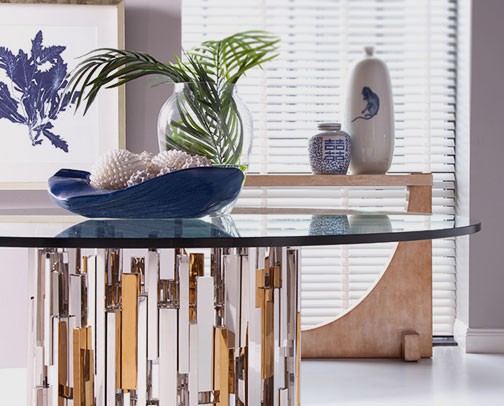Fine home furnishings are designed and crafted for lasting enjoyment. As with any quality product, care and maintenance are critical to ensuring that longevity. The following are recommendations for the various materials and finishes in the Lexington Home Brands product assortment, across all brands.
- Dust with a clean microfiber or lint-free cloth, rubbing with the grain direction
- Avoid using furniture waxes, polishes or oils that can build up on surfaces
- Clean surfaces with mild soap and water solution, drying immediately afterward
- Wipe up spills or smudges immediately
- Protect surfaces from scratches using felt pads, placemats or tablecloths
- Never set drinks or liquids directly on surfaces
- Do not leave plastic or rubber materials on surfaces
- Avoid prolonged exposure to direct sunlight or heat sources
- Avoid contact with hot dishes or objects
- Avoid contact with solvents like nail polish remover or alcohol
- Do not use cleaners on metal, brass or stone items
Casters: The standard casters on all Artistica Home upholstered chairs are designed for use on carpeted, porcelain, ceramic or stone surfaces. Most hardwood and vinyl floors have a softer surface which may cause casters to leave tracking marks. In cases where the chairs are used directly on hardwood flooring, engineered flooring or vinyl surfaces, the standard casters should be replaced with hardwood-safe casters. MORE INFO
- Avoid placing furniture in direct sunlight or near a heat source
- Vacuum furniture to prevent the accumulation of dust or debris
- Flip cushions and pillows regularly to keep filling equally distributed
- Fluff pillows after use to maintain shape
- Never remove cushion covers for cleaning
- Never put cushion covers into a washer or dryer
- All fabrics and leathers have specific cleaning codes
- Use a professional cleaning service whenever possible
- Allowing pets on upholstery will void the fabric warranty
General Care:
- Protect from sunlight, as exposure over time will cause fading.
- Always maintain at least two feet of space between leather furniture and any heating source, such as vents or radiators. This helps prevent the leather from drying out over time.
- To remove accumulated surface dust, vacuum or wipe with a clean white cloth on a regular basis.
- For oil, butter, or grease stains, absorb any excess with a clean dry cloth. Then leave the stain alone. If it does not dissipate completely, it will become part of the leather’s unique characteristics.
- Never use saddle soaps, cleaning solvents, furniture polish, oils, varnish, abrasive cleaners, detergents, or ammonia on upholstery leather. Lexington leathers have been permanently preserved during the tanning process and require only simple cleaning. Harsh chemicals may alter or damage leather.


